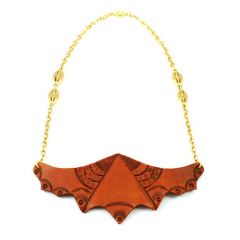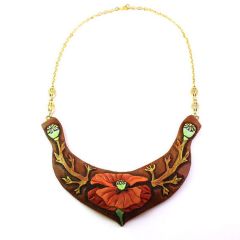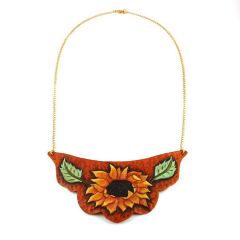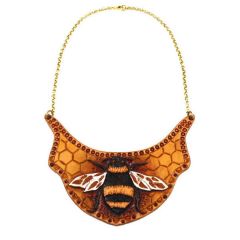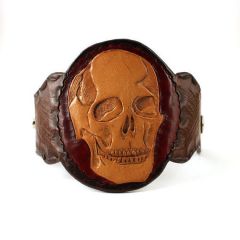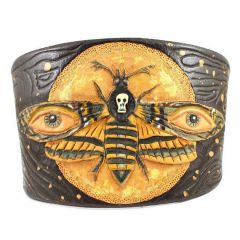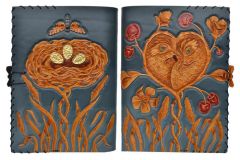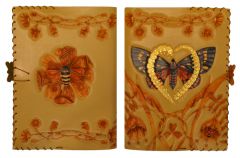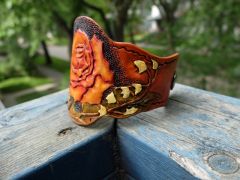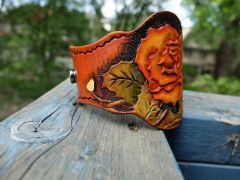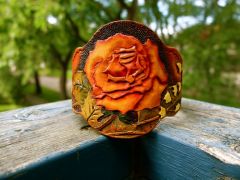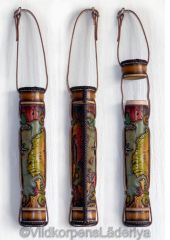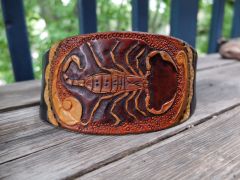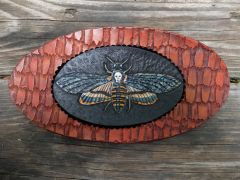-
Posts
45 -
Joined
-
Last visited
Content Type
Profiles
Forums
Events
Blogs
Gallery
Everything posted by miel zaphia
-
I was using a sort of rubber cement glue. (made for leather) its from germany. maybe I was using too much? Its hard to apply thinly. perhaps the cement isn't the best option as it is so tacky.
- 8 replies
-
- leather belt buckle
- leather covered belt buckle
- (and 2 more)
-
Thanks penguineer. Leaving excess room seems like a good idea. However, I bought those prefabricated pieces from Tandy (the front and back pieces are cut out to exact size, and already have their stitch holes punched). At this point I have a bunch on hand and am hoping to use them…. Wet forming the front pieces to the metal hardware seems like a good idea. Is it okay to wet form leather that has already been tooled dyed and finished with a top coat????
- 8 replies
-
- leather belt buckle
- leather covered belt buckle
- (and 2 more)
-
Thanks DS Straps! That is kind of what I did, but unfortunately trimming the edges after it is assembled is quite challenging to execute! It just doesn't leave a professional looking edge. I did end up doing what you suggested and gluing the two pieces together before stitching, but it just resulted in my needle and thread getting gummy (I just have leather rubber cement type glue). There must be a cleaner and easier way to do this! Hmm… Well hopefully someone chimes in.
- 8 replies
-
- leather belt buckle
- leather covered belt buckle
- (and 2 more)
-
Hey everyone. Just want to give an advance thank-you to anyone who takes the time to help me out with this. I've been doing leatherwork casually over the past year (I have a new baby so that's all the time I can afford). Tooling and dying are very fun and comfortable for me however I have been avoiding projects that involve stitching and hardware. I want to get over this hump so I have tooled up a few belt buckles and am ready to stitch them up with a metal hardware interior (see attached photo). This is my second attempt at stitching up belt buckles. The first one went quite horribly to be honest and I am hoping to avoid some of the pitfalls i experienced my first time around but haven't been able to find too many tips and tricks online. Here are some of the problems I encountered my first round sewing a leather belt buckle onto metal hardware: 1. Couldn't seem to get the holes aligned, and the layers would shift around when adjusting the buckle in my stitching pony which was quite frustrating 2. because the front leather piece has to stretch over the curved metal hardware, it seemed "smaller" than the back piece once stitched, and the edges of the front and back piece of leather would not align giving it a sloppy appearance. It looked like there was a small gap between the two layers of leather rather than a nice solid edge. The back layer also overlapped the front. I tried to remedy this by gluing them together, and carefully trimming and burnishing the edges while sewn on the metal backing. This was quite a challenge and didn't go so well and I lost the perfect oval shape of the belt buckle in the process! Yikes. I'm sure some of you have sewn hundreds of leather belt buckles with a nice refined edge. Is there some essential step i'm overlooking? Any hints to keep things aligned and make the edges look professional and neat? I have worked hard at tooling and dying these pieces and would be sad if I destroyed them in the final steps of finishing the belt buckle! Once again, I would appreciate any tips! Thanks.
- 8 replies
-
- leather belt buckle
- leather covered belt buckle
- (and 2 more)
-
From the album: recent work
-
From the album: recent work
-
From the album: recent work
-
From the album: recent work
-
From the album: recent work
-
From the album: recent work
-
Probably a bit late to comment on this forum but can report very similar issues with the Tandy Antique Gels. I absolutely love the colour the the Saddle Tan Antique Gel and used it on several products, one being a cuff I planned to wear for my friends wedding: sealed it with several coats of tan note and wore it on a hot summer day for a couple hours and sure enough the dye was bleeding through the finish onto my arm! I happen to love this cuff so i tried making a dubbin to apply over the finish as an extra layer of protection- this stuff is virtually waterproof. Wore it out again, and the Antique gel bled through once again- a lot less but still bleeding. This just won't do if I ever plan to sell these items i can't take the risk of it rubbing off on someones crisp white shirt. I've tried sealing it with Fiebings acrylic resolene and an extra coat of my homemade dubbin as a precautionary measure on a dog leash I made for a friend. It just seems a shame to waste all this Gel I bought as I have it in several colours. So far they have reported no rub off. If only I could find an antique stain that offered a similar vibrant saddle tan colour. If anyone is using these Antique Gel on heavy wear items and has found a good sealant for it please let me know. Also would love to see an item dyed with the Fiebings Antique Paste in Saddle Tan to compare. Thanks
-
-
The fact that you continually are able to come up with these lovely, individual and unique designs while working within the same motifs just astounds me! Can't describe it in words but will attempt to anyway: whimsical, enchanting and rapturous. Your designs just keep getting better! I love all the dimension and depth-of-field you so often employ.
-
- 1 comment
-
- bugs
- caterpillars
- (and 8 more)
-
From the album: new experiments
-
From the album: new experiments
-
From the album: new experiments
-
-
Wow! What an informative tutorial. Thanks for taking so much time to put it together and share it with us.
-

Question About Using/tooling Belly Leather
miel zaphia replied to miel zaphia's topic in Getting Started
Thanks for the advice! I'll give that a try (and now I have the leather I need if I do want to make belts and guitar straps in the future.- 11 replies
-
- belly leather
- cuff bracelets
-
(and 1 more)
Tagged with:
-

Question About Using/tooling Belly Leather
miel zaphia replied to miel zaphia's topic in Getting Started
Wow! Thanks for all the feedback guys and gals. This has been such an excellent resource for me and I have avoided many mistakes through reading these forums and finally thought i'd chip in with my own question. Hennessy: Thanks for the response. What is the best way for identifying the weakest "Trashy spots" of the grain?" I've noticed on the backs I ordered there are some areas/patches especially around the edges where the grain side looks darker in color and much hairier/looser. Is this what you are referring to? Any input is appreciated! Also, how exactly can you "tool thru a backing"? on belly leather Not sure I've ever heard of this technique! Are you refering to securing/gluing/taping your leather down before tooling? Thanks!- 11 replies
-
- belly leather
- cuff bracelets
-
(and 1 more)
Tagged with:
-

Question About Using/tooling Belly Leather
miel zaphia replied to miel zaphia's topic in Getting Started
Thanks! The only problem is there just aren't too many people doing leatherwork where I live (Winnipeg Manitoba). More people making moccasins etc with deer and moosehide. When I started I was raiding the local tandy scrap bin but it's so far from my house and quite unreliable (sometimes great scraps, more often, not. If I could find someone who was willing to sell me some quality scraps that would certainly be ideal. I do however intend to make some larger items such as guitar straps and womens belts for which I will need larger pieces of leather (but now I have that after my W&C purchase).- 11 replies
-
- belly leather
- cuff bracelets
-
(and 1 more)
Tagged with:
-
Hey there, Some questions on using Belly leather. My apologies if this post is a bit long winded. From what I have read it is more flexible with a looser grain. How does this effect tooling & carving? Will it maintain a good deep impression as the item ages? Can it be used for small items such as belt buckles, cuff bracelets and flask covers without a huge compromise in quality despite the looser grain and stretchiness? Why do many people consider bellies to be scrap leather? (the low cost is obviously appealing to a beginner but I don't want to make useless products just to save money) I just made my first leather purchase at W & C, directly from the tannery. I spoke with the gentleman on the phone and mentioned this was my first time purchasing leather, that I was on a budget and wondered whether it would be more cost effective to get a full side (belly and all), or just the back (less square footage with belly removed). I naively was under the impression the cost would be the same per squre foot, and the guy said nothing to indicate otherwise on the phone. He said the back would be more cost effective as it was smaller and the belly is removed...however when I recieved my invoice the price listed per square foot was $8.25 rather than the $7.15 I was expecting- uh oh! I ignorantly failed to notice at the bottom of the website page, the little box that it mentioned an additional $1.20 surcharge per square foot for the back. The man on the phone never mentioned the surcharge and actually quoted me the price without it (a couple hundred dollars less than the actual cost!). Oops! Never going to do that again! SO, to make a long story short I plan to order a full side next time, and am wondering, what to do with that belly leather? Obviously the quality is not the same, but if I am able to make small items that hold their tooling and don't require much strength with belly leather it would be fantastic! In that case I could save a tonne of money and buy bellies for these kind of items. However I do plan to sell some of my cuff bracelets and don't want to be giving a customer a substandard product. Any thoughts/opinions on the matter? Anyone with some experience in regards to using/tooling/dying the bellies? Here are some pictures of the kind jewellery/items I want to make (unassembled):
- 11 replies
-
- belly leather
- cuff bracelets
-
(and 1 more)
Tagged with:
-
From the album: new experiments
scorpion cuff bracelet made for my uncle. had fun using the seeder stamp to make a pebbled background. freehanded the spiral crustation- would do it differently if I made another. -
From the album: new experiments
death's head moth cuff bracelet ready to be stitched. the background scales are inspired by the texture of magnified butterfly wings.




